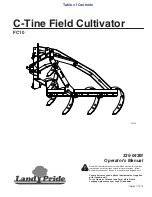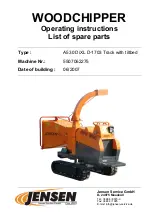
D-EIMWC003H02-18_02EN - 9/34
1.5
Safety installation
The chiller has to be installed in open air or machinery room (location classification III).
To ensure location classification III a mechanical vent on the secondary circuit(s) has to be installed.
Local building codes and safety standards shall be followed; in absence of local codes and standards refer to EN 378-3:2016
as a guide.
In paragraph “Additional guidelines for safe use of R1234ze(E)” there are provided additional informations that should be
added to the requirements of safety standards and building codes.
1.5.1
Additional guidelines for safe use of R1234ze(E) for equipment located in the open air
Refrigerating systems sited in the open air shall be positioned to avoid leaked refrigerant flowing into a building or otherwise
endangering people and property.
The refrigerant shall not be able to flow into any ventilation fresh air opening, doorway, trap door or similar opening in the
event of a leak. Where a shelter is provided for refrigerating equipment sited in the open air it shall have natural or forced
ventilation.
For refrigeration systems installed outside in a location where a release of refrigerant can stagnate e.g. below ground, then
the installation shall comply with the requirements for gas detection and ventilation of machinery rooms.
1.5.2
Additional guidelines for safe use of R1234ze(E) for equipment located in a machinery room
When a machinery room is chosen for the location of the refrigerating equipment it shall be located in accordance with local
and national regulations. The following requirements (according to EN 378-3:2016) can be used for the assessment.
•
A risk analysis based on the safety concept for the refrigerating system (as determined by the manufacturer and
including the charge and safety classification of the refrigerant used) shall be conducted to determine whether it is
necessary to place the refrigerating system in a separate refrigeration machinery room.
•
Machinery rooms should not be used as occupied spaces. The building owner or user shall ensure that access is
permitted only by qualified and trained personnel doing the necessary maintenance to the machinery room or
general plant.
•
Machinery rooms shall not be used for storage with the exception of tools, spare parts and compressor oil for the
installed equipment. Any refrigerants, or flammable or toxic materials shall be stored as required by national
regulations.
•
Open (naked) flames shall not be permitted in machinery rooms, except for welding, brazing or similar activity and
then only provided the refrigerant concentration is monitored and adequate ventilation is ensured. Such open
flames shall not be left unattended.
•
A remote switching (emergency type) for stopping the refrigerating system shall be provided outside the room (near
the door). A similar acting switch shall be located at a suitable location inside the room.
•
All piping and ducting passing throught floors, ceiling and walls of machinery room shall be sealed.
•
Hot surfaces shall not exceed a temperature of 80 % of the auto-ignition temperature (in °C) or 100 K less than the
auto-ignition temperature of the refrigerant, whichever is higher.
Refrigerant Auto ignition temperature Maximum surface temperature
R1234ze
368 °C
268 °C
•
Machinery rooms shall have doors opening outward and sufficient in number to ensure freedom for persons to
escape in an emergency; the doors shall be tight fitting, self-closing and so designed that they can be opened from
inside (antipanic system).
•
Special machinery rooms where the refrigerant charge is above the practical limit for the volume of the room shall
have a door that either opens directly to the outside air or through a dedicated vestibule equipped with self-closing,
tight-fitting doors.
•
The ventilation of machinery rooms shall be sufficient both for normal operating conditions and emergencies.
•
Ventilation for normal operating conditions shall be in accordance with national regulations.
•
The emergency mechanical ventilation system shall be activated by a detector(s), located in the machinery room.
o
This ventilation system shall be:
▪
independent of any other ventilation system on the site.
▪
provided with two independent emergency controls one located outside the machinery room, and
the other inside.
o
The emergency exhaust ventilation fan shall:
▪
Be either in the air flow with the motor outside the airflow, or rated for hazardous areas (according
to the assessment).
▪
Be located to avoid pressurization of the exhaust ductwork in the machinery room.
▪
not cause sparks to occur if it contacts the duct material.
o
Airflow of the emergency mechanical ventilation shall be at least
𝑉 = 0,014 × 𝑚
2
3
⁄
where
V
is the air flow rate in m
3
/s;
m
is the mass of refrigerant charge, in kg, in the refrigerating system with the largest charge,
any part of which is located in the machinery room;
0,014 is a conversion factor.
o
Mechanical ventilation shall be operated continuously or shall be switched on by the detector.
•
Detector shall automatically activate an alarm, start mechanical ventilation and stop the system when it triggers.
•
The location of detectors shall be chosen in relation to the refrigerant and they shall be located where the refrigerant
from the leak will concentrate.










































